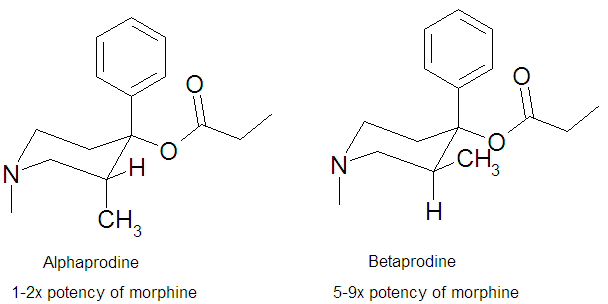Prodine
 From Wikidoc - Reading time: 2 min
From Wikidoc - Reading time: 2 min
 | |
| Clinical data | |
|---|---|
| Synonyms | Prodine, Prisilidine, Nisentil |
| Identifiers | |
| |
| CAS Number | |
| PubChem CID | |
| E number | {{#property:P628}} |
| ECHA InfoCard | {{#property:P2566}}Lua error in Module:EditAtWikidata at line 36: attempt to index field 'wikibase' (a nil value). |
| Chemical and physical data | |
| Formula | C16H23NO2 |
| Molar mass | 261.359 g/mol |
Editor-In-Chief: C. Michael Gibson, M.S., M.D. [1]
Please Take Over This Page and Apply to be Editor-In-Chief for this topic: There can be one or more than one Editor-In-Chief. You may also apply to be an Associate Editor-In-Chief of one of the subtopics below. Please mail us [2] to indicate your interest in serving either as an Editor-In-Chief of the entire topic or as an Associate Editor-In-Chief for a subtopic. Please be sure to attach your CV and or biographical sketch.
Overview[edit | edit source]
Prodine (Prisilidine, Nisentil) is an opioid analgesic that is an analogue of pethidine (meperidine).
There are two isomers of prodine, Alphaprodine and Betaprodine.[1] Betaprodine is some 5x more potent than alphaprodine,[2] but is metabolised more rapidly, and only alphaprodine was developed for medicinal use. It has similar activity to pethidine, but with a faster onset of action and shorter duration.[3]
Alphaprodine was sold under several brand names, mainly Nisentil and Prisilidine. It was mainly used for pain relief in childbirth[4] and dentistry,[5] as well as for minor surgical procedures.
Prodine has similar effects to other opioids, and produces analgesia, sedation and euphoria. Side effects can include itching, nausea and potentially serious respiratory depression which can be life-threatening. Respiratory depression can be a problem with alphaprodine even at normal therapeutic doses.[6]
References[edit | edit source]
- ↑ Beckett AH, Walker J. The configuration of alphaprodine and betaprodine. Journal of Pharmacy and Pharmacology. 1955 Dec;7(12):1039-45.
- ↑ John Bedford Stenlake. Foundations of Molecular Pharmacology. ISBN 0-485-11171-3
- ↑ Fung DL, Asling JH, Eisele JH, Martucci R. A comparison of alphaprodine and meperidine pharmacokinetics. Journal of Clinical Pharmacology. 1980 Jan;20(1):37-41.
- ↑ Burnett RG, White CA. Alphaprodine for continuous intravenous obstetric analgesia. Obstetrics and Gynecology. 1966 Apr;27(4):472-7.
- ↑ Carter WJ, Bogert JA. An effective pre-medication procedure for dental patients. Journal of the Missouri Dental Association. 1966 Jun-Jul;46(6):8-9.
- ↑ Fuller JD, Crombleholme WR. Respiratory arrest and prolonged respiratory depression after one low, subcutaneous dose of alphaprodine for obstetric analgesia. A case report. Journal of Reproductive Medicine. 1987 Feb;32(2):149-51.
 KSF
KSF